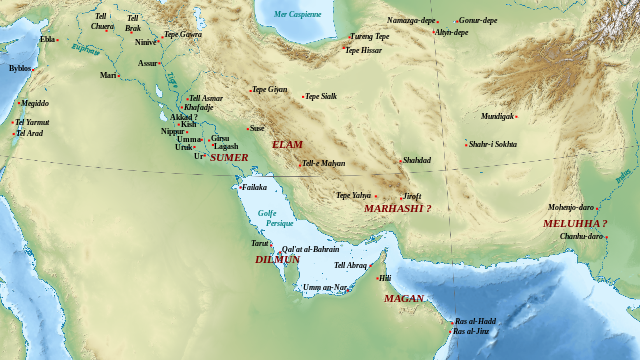
| MARHASI
Possible location of Marhasi, to the east of Sumer and the Akkadian Empire Marhaši (Marhashi, Marhasi, Parhasi, Barhasi; in earlier sources Warahše. Akkadian: "Parahshum" pa2-ra-ah-shum2-ki) was a 3rd millennium BC polity situated east of Elam, on the Iranian plateau. It is known from Mesopotamian sources, but its precise location has not been identified, though some scholars link it with Jiroft. Francfort and Tremblay on the basis of the Akkadian textual and archaeological evidence, proposed to identify the kingdom of Marhashi and Ancient Margiana.
History :
Account
of the victories of Rimush, king of Akkad, over Abalgamash, king
of Marhashi, and upon Elamite cities. Louvre Museum AO5476. In
several inscriptions, Rimush described his conquest of Elam and
Marhashi far to the east of Sumer, even mentioning victories over
troops of Meluhha (probably India).
It is also recorded that the Awan kings of Elam were in conflict with a Sumerian ruler's attempt to seize the market at Warakshe, a kingdom apparently near Elam on the Iranian plateau, rich in luxury products of all types, especially precious stones.
During the Akkadian Empire, Parahshum ("Marhashi" in Sumerian) was conquered by Sargon the Great, and king Abalgamash of Parahshum and his general Sidgau, along with Luh-ishan of Awan, rebelled unsuccessfully against Rimush, while Hishep-ratep of Awan in alliance with Warakshe was defeated by Naram-Sin.
King Shulgi of the Ur-III dynasty gave his daughter Nialimmidashu in marriage to king Libanukshabash of Marhashi in his 18th year, in an attempt to forge an alliance, but this proved short-lived, for Shulgi's successor Amar-Sin records having to campaign against their new king, Arwilukpi.
Hammurabi of Babylonia's 30th year name was "Year Hammurabi the king, the mighty, the beloved of Marduk, drove away with the supreme power of the great gods the army of Elam who had gathered from the border of Marhashi, Subartu, Gutium, Tupliash (Eshnunna) and Malgium who had come up in multitudes, and having defeated them in one campaign, he (Hammurabi) secured the foundations of Sumer and Akkad."
Rulers
of Marhasi :
1.
Migirenlil (c. 2550 BC)
"Abalgamash, King of Marhashi" (Abalgamash Lugal Paraahshum-ki) on one of the Rimush inscriptions (Louvre Museum, AO 5476)
Prisoner of the Akkadian Empire, nude, fettered, drawn by nose ring, with pointed beard and vertical braid. Fragment of a vase possibly from Warka, ancient Uruk. Thought to depict a typical Marhasi. 2350-2000 BCE, Louvre Museum AO 5683.
The area of Jiroft and the Jiroft culture may correspond to the ancient country of Marhashi See also :
•
List
of rulers of the pre-Achaemenid kingdoms of Iran
• Subartu
Source :
https://en.wikipedia.org/ |

.jpg)


